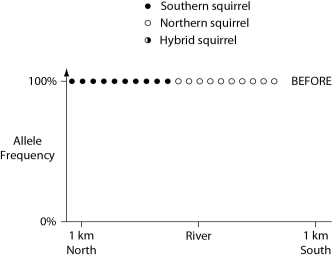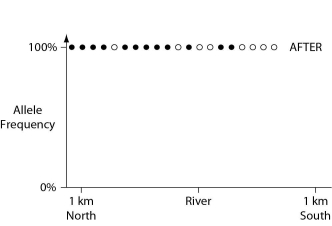Multiple Choice
In a hypothetical situation, the National Park Service, which administers Grand Canyon National Park in Arizona, builds a footbridge over the Colorado River at the bottom of the canyon. The footbridge permits migration to occur between populations of two closely related antelope squirrels. Previously, one type of squirrel had been restricted to the terrain south of the river, and the other type had been restricted to terrain on the north side of the river. Immediately before and 10 years after the bridge's completion, researchers collected 10 antelope squirrels from both sides of the river, took blood samples, and collected frequencies of alleles unique to the two types of antelope squirrels (see the graphs in Figures 22.2 and 22.3) .
 Figure 22.2
Figure 22.2
 Figure 22.3
Figure 22.3
-The data in these graphs indicate that
A) a hybrid zone was established after the completion of the bridge.
B) there was no migration between the two squirrel populations after the bridge was completed.
C) gene flow occurred from one type of squirrel into the gene pool of the other type of squirrel.
D) two-way migration of squirrels occurred across the bridge, but without hybridization.
E) some northern squirrels migrated south, but no southern squirrels migrated north across the bridge.
Correct Answer:

Verified
Correct Answer:
Verified
Q2: Which of the following factors would not
Q4: The next few questions refer to the
Q9: Which of the various species concepts distinguishes
Q14: The most likely explanation for the high
Q21: The next few questions refer to the
Q25: The phenomenon of fusion is likely to
Q29: The next few questions refer to the
Q39: The origin of a new plant species
Q41: What is true of macroevolution?<br>A) It is
Q57: According to the concept of punctuated equilibrium,